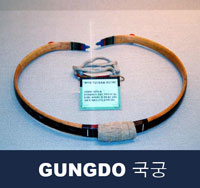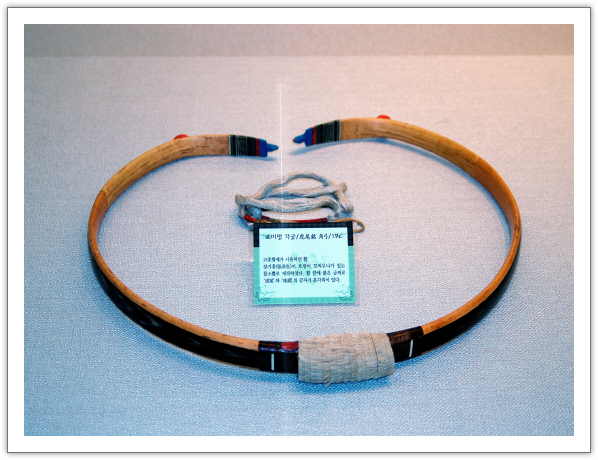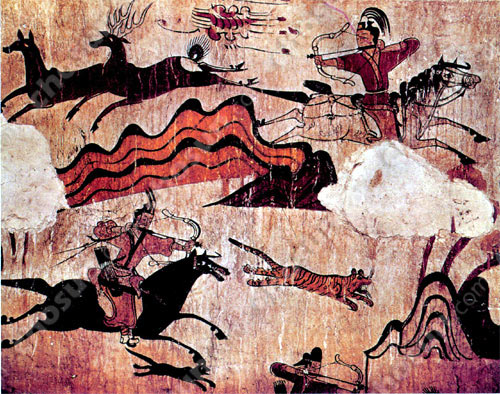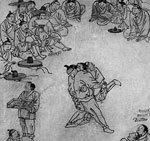Taekwondo 태권도Taekwondo Preschool
Korean martial arts are military practices and methods which have their place in the history of Korea but have been adapted for use by both military and non-military personnel as a method of personal growth or recreation.

About Gungdo 국궁
Korean martial arts are military practices and methods which have their place in the history of Korea but have been adapted for use by both military and non-military personnel as a method of personal growth or recreation.
The Korean Bow (Korean: 각궁, Gak-gung) is a water buffalo horn-based composite reflex bow, standardized about 1900 AD from the variety of such weapons in earlier use. It uses with thumb draw. The Korean Thumb ring is different from the Manchu, Mongol, or the Turkish Thumb Ring. It comes in two styles, male and female. Male thumb ring sticks out as an extra appendage, while the female thumb ring overs the front joint of the thumb only. Also, the arrow is laid on the right side of the bow, unlike the western bow, where the arrow is laid on the left side of the bow. Gungsul, also written goongsul, literally means "the Craft of the bow." It is also called Korean traditional archery.

History of Military Origin and Usage
The reflex bow had been the most important weapon in Korean wars with Chinese dynasties and nomadic peoples, recorded from the 1st century BCE. Legend says the first king and founder of the Goguryeo, Go Jumong, was a master of archery, able to catch 5 flies with one arrow. Park Hyeokgeose, the first king of the Silla, was also said to be a skilled archer. Rumors of archers in Goguryeo and Silla presumably reached China; the ancient Chinese gave the people of the north east, Siberia, Manchuria and the Korean Peninsula, the name of Dongyi (東夷), the latter character (夷) being a combination of the two characters for "large" (大) and "bow" (弓).

However, the word 夷 was first used in Chinese history referring to the people South of Yellow River over 5,000 years ago. Later, when Yi 夷 people joined the tribes of Hua Xia [華夏] Chinese, 夷 meant outsiders. By that time, DongYi refers to Korean, as in Outsiders from the East.
With the Mongol Conquest of Korea, archery became the main stay of Korean military. Sword and spear of Korea and China did nothing to stop the Mongol archery, so were quickly discarded in favor of the ultimate weapon, the composite bow. Yi Seonggye, the founding king of Joseon was known to have been a master archer. In a battle against Japanese pirates, Yi Seonggye, assisted by Yi Bangsil, killed the young samurai commander "Agibaldo" with two successive arrows, one arrow unhelmeting the warrior, with the second arrow entering his mouth. In his letter to General Choi Young, Yi Seonggye lists as one of five reasons not to invade Ming Dynasty as during the monsoon season, glue holding together the composite bow weakens, reducing the effectiveness of the bow.
Founding of Joseon dynasty saw the retention of the composite bow as the main stay of the Joseon military. Archery was the main martial event tested during the military portion of the national service exam held annually from 1392 to 1894. Under Joseon, archery reached its zenith, resulting in the invention of pyeonjeon, which saw great service against the Japanese in 1592 and against the Manchus in early 1600s.
Until the Imjin wars, archery was the main long-range weapon system. During that war, the tactical superiority of the matchlock arquebus became apparent, despite its slow rate of fire and susceptibility to wet weather. However, it was the Korean composite bow, referred to as the "half bow" by the Japanese, that halted the Japanese at the Battle of Haengju as well as at the Battle of Ulsan. Although Joseon adopted the arquebus during the Imjin War, the composite bow remained the main stay of its Army until the reforms of 1894. Under King Hyojong's military reforms, an attempt was made to revive horse archery as a significant element of the military. It was also practiced for pleasure and for health, and many young males and a some many females - including the king - would spend their free time practicing it.
Transition to Recreational Sport
In 1899, the visiting Prince Heinrich of Prussia expressed his astonishment to Emperor Gojong at a traditional archery demonstration. The Prince, hailing from a militarized Prussian culture, sought out demonstrations of Korean martial arts, and Archery was the most impressive among the arts demonstrated. He was familiar with Turkish and Hungarian Archery of Europe, which were similar to Korean Archery. Prince Heinrich suggested sporterizing the art to make it a national sport. The emperor, convinced by the Prince, decreed "let people enjoy archery to develop their physical strength" and established an archery club. In the subsequent standardization of Korean archery, the nature of the bow and the arrow was standardized, as was the range of the targets. Korean traditional archery now uses one specific type of composite bow, bamboo arrows, and a standard target at a standard distance of 120 bo (about 145 meters). Korean Archery as a sport developed under the Japanese Occupation, its textbook, "Joseon eui Goongdo" being published in 1920.
Construction and Competition
The traditional Korean bow is a highly reflexed version of the classic Eurasian composite bow. The core is bamboo, which is sinew backed, with oak at the handle. On the belly is water buffalo horn. The siyahs, the stiffened outer ends of the limbs, are made of either mulberry or black locust spliced (v-splice) onto the bamboo. The glue is made from isinglass. Over the sinew backing is a special birch bark that is imported from Northeast China. It is soaked in sea water (possibly for one year). It is applied to the back using diluted rubber cement (using benzene as the solvent). No sights or other modern attachments are used.
The draw weights vary, but most are above twenty kilograms. The cost for this type of bow is in the US$800 range. For a similar modern version made of laminated fiberglass, the cost is US$200–300. For most competitions, either bow may be used, with carbon-fiber arrows, but for national competitions, only the composite bow and bamboo arrows may be used. Korean archers have also been very successful in Olympic and other competitions with more modern types of bow.
The sukgung, a kind of crossbow, and the Gak-gung are a small but very powerful bow. A sukgung can shoot up to 400 meters while a Gak-gung can shoot up to 350 meters.
The art of constructing traditional Korean bows was designated an Important Intangible Cultural Property in 1971.
RESOURCES
This article uses material from the Wikipedia article "Gungdo", which is released under the Creative Commons Attribution-Share-Alike License 3.0.



















